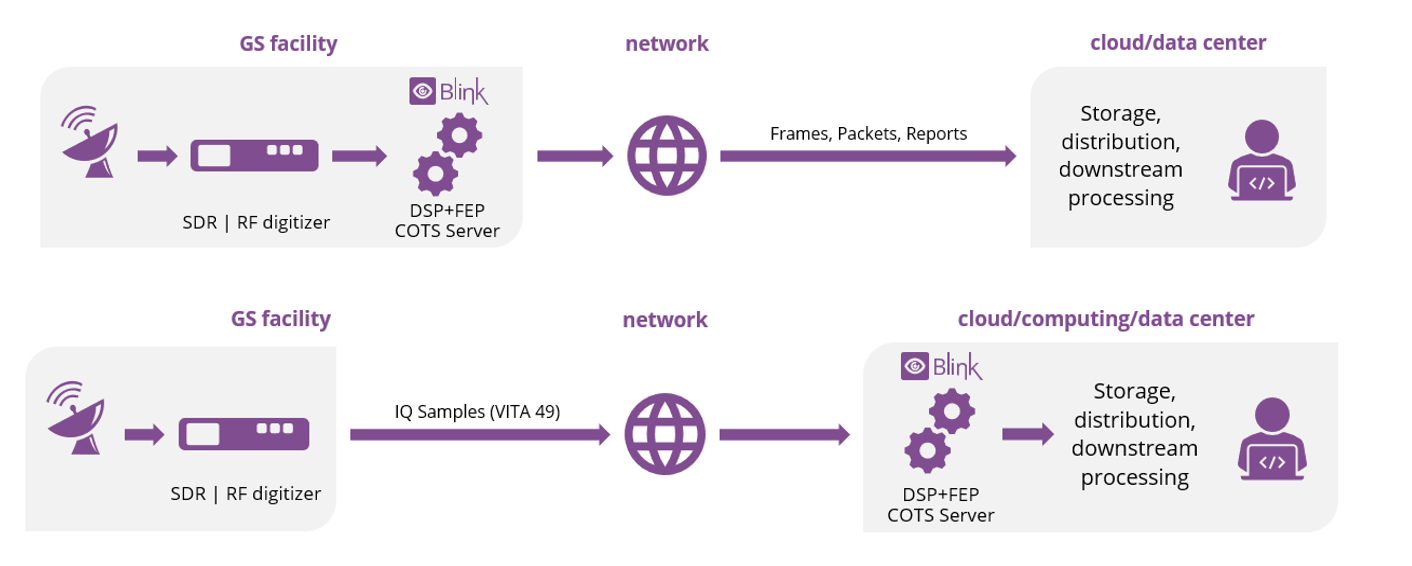The project ‘Satellite Data Acquisition in the Blink of an Eye - BLINK’ has received funding from the European Union’s Horizon 2020 research and innovation programme under grant agreement No. 812471.
Project Description
Blink is an ultra-fast satellite telemetry acquisition and processing solution built nearly completely in software. The aim of the solution is to replace currently used expensive and hard-to-maintain hardware demodulators and to provide an affordable, scalable and flexible solution for both big and small satellite missions.
Within the scope of this project, Amphinicy has successfully completed implementation of Blink: a software-based solution that is designed as a configurable, multi-mission, multi-standard solution, scalable enough to support even the most demanding, high-data-rate missions (>1 Gbps). The receiver consists of 3 components and a lot of work and knowledge went into making them:
- Design, test and production preparation of new Blink high-throughput Ultra SDR platform that currently primarily serves as an IF digitizer (analog-to-digital converter)
- Design, test and production preparation of Blink DSP (digital signal processing)
- Upgrades of the Blink FEP (front-end processor) component to support additional standards and integrate processing statistics coming from Blink DSP
The result of the project is a high-throughput, CE-certified Blink Ultra SDR solution.

Blink Ultra SDR provides the following features:
Multi-channel operation
- 2 Rx and 1 Tx channel
- phase-aligned, tunable, independent, full duplex
Input power level
- -50 to -10 dBm
Processing
- Powerful FPGA for on-device processing if required
IF frequency selection
- 300 MHz to 2 GHz with 1 Hz step
- up to 700 MHz bandwidth per channel
Physical interfaces
- 192x64 LCD with multi-function keys for status overview
- RF SMA 50 Ohm
- Clock sync - 10 MHz I/O, GNSS
- 1GbE for monitor and control
- 4x10GbE for data transfer
Sampling
- Up to 1GSps I+Q, 16 bits per sample
Software interfaces
- SNMP, REST, Web GUI
- Lossless 32+ Gb/s full-duplex data streaming
Environment
- Operating temperature 10°C to 40 °C, storage -20°C to 60 °C, humidity 10% to 90%
Format
- 1U
Power
- 220 W
Blink software components (digital signal processing and front-end processing) have been upgraded and scaled to multi-mission, multi-standard operational mode, achieving processing data rates just over 1,2 Gbps2. They provide the following features:
Multi-channel operation
- Data recording & playback
- CCSDS CCM
- DVB-S2 CCM/VCM/ACM
Multi-mission support
- set up via mission configuration files
Data rates
- Up to 1.2Gbps per channel, up to 500 MHz channels
Modulation options
- QPSK, OQPSK, 8PSK, 16/32APSK
FEC and coding
- Viterbi 1/2, 2/3
- LDPC, BCH (DVB-S2 - EN 302 307 - V1.4.1)
- NRZ-M, NRZ-S, NRZ-L
Signal processing
- Automatic gain control (AGC)
- Arbitrarily-shaped, arbitrarily precise filters
- Rapid frequency and phase lock, Doppler shift compensation
- ASM-based phase disambiguation
- Declarative modular processing chain
Test modulator
- Including channel effect simulators
Front-end processing
- CCSDS and DVB-S2 protocols
- Frame synchronisation, scrambling/descrambling
- Reed-Solomon (223/255, 239/255)
- CRC (8-, 12- and 16-bit)
- Instrument data de-multiplexing
- HTML/XML/JSON processing reports with 30+ types of stream processing events and interactive event timeline
- Included command-line tool for flexible offline diagnostics
Data, control and status interfaces & protocols
- control: SNMP, TCP-IP socket, web UI
- in: VITA 49/VRT, int8/16, FP16/32
- out: CADU, VCDU, BB frames, TS/GS/ISP packets
Operating system
- GNU/Linux
Hardware environment
- COTS standard server
BLINK MARKET POTENTIAL
Blink's modular architecture and its support for standard interfaces allow it to easily integrate into practically any ground station environment. Its architecture supports the deployment of Blink software components in virtual environments as well: in particular cloud environments, which become even more important taking into considerations large ICT giants such as Amazon building their own ground stations, providing ‘ground station as a service’.

Blink software can be combined with COTS digitizers or software-defined radios as well as with the Blink Ultra SDR.
Blink DSP and FEP modules can be integrated with a COTS digitizer to provide a modern, flexible and cost-effective modem and front-end processor with a number of benefits:
- Superior value for money compared to traditional solutions
- Flexible licensing
- Maximum utilization of COTS components, reducing vendor-lock-in and making it much easier to e.g. have on-site spares
- Evolve-as-you-grow: software is much easier to install and upgrade when needed
Combined with Blink Ultra's modern, legacy-free design that pushes the limits of today's SDR capabilities in a compact, cost effective package, this approach provides the following benefits:
- Multi-channel, wideband, high-resolution operation that majority of COTS digitizers and SDRs don't support
- High flexibility: can work as a digitizer with a transmission channel but can take over (parts of) DSP processing as well
- Significantly more affordable than competing solutions
Blink solution is complemented with Amphinicy’s white-labelled, advanced monitoring and controlling system Monica, which provides a powerful and easy to use user interface to Blink.
Relevant technology and industry related news
ICT industry meets space industry:
http://satellitemarkets.com/market-trends/earth-observation-market-generate-us-73-billion-2030-convergence-trends
About growing Earth observation market:
https://spacenews.com/how-aws-is-opening-up-space-with-the-cloud/
Big space data and services:
http://satellitemarkets.com/market-trends/prospects-satellite-data-services-market
Shift in satellite data reception with Blink:
https://amphinicy.com/news-and-press/news/blink-receiving-dvb-s2-12-gbs-wonderful-closing-year
